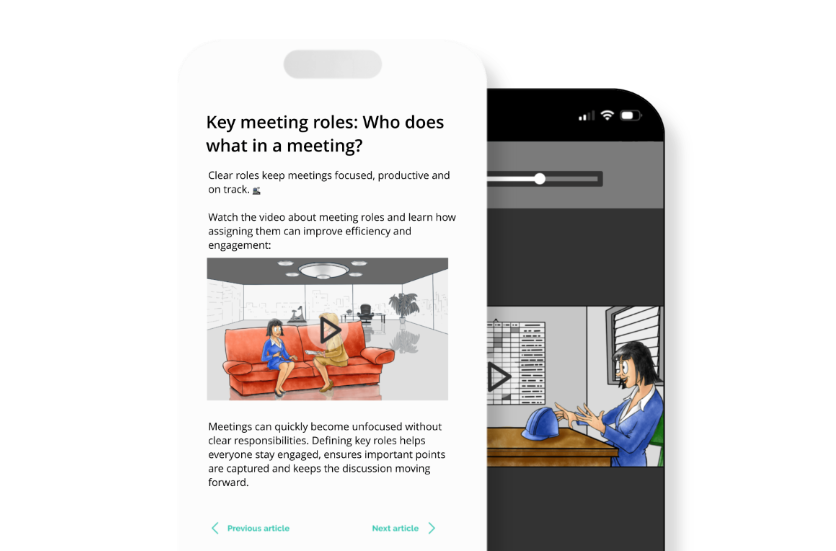
In early 2015 Mark and I were having a chat on a chairlift in Japan. Mark mentioned that Holly, his girlfriend (now wife) had spoken to him about a cool idea. Holly has a digital agency background too and had noticed that many client’s didn’t fully understand the digital space. This often resulted in miscommunication and mismatched expectations, negatively impacting project team relationships and the success of the projects themselves.
This struck a chord with me right away, since I had experienced the exact same problem at webqem. Such a big part of a digital producer’s role is education. Educating clients about how digital works, how to run digital projects, what we need from them etc.
A while ago I’d had the throwaway idea of creating short training videos, that clients had to watch before starting a project with us. The idea was the video would educate them about the phases in the project and key concepts that would come up such as wireframes, prototypes etc, saving time and minimising miscommunication. However like many ideas, it quickly gathered dust.

So, back to the chairlift. Much excitement ensued and we agreed to explore it further to see if it had legs.
Time for some research
We returned to Sydney and did some research. We discovered that online training in the US had really taken off, especially in vocational areas such as coding. Treehouse, Udemy, Code Academy were all wildly successful. Lynda.com was in the process of being bought by LinkedIn for US$1.5 billion. Our excitement level was rising rapidly.
We then turned our focus to the Australian market. It became clear that we are way behind the US in online training. Companies such as General Assembly, ADMA and The Knowledge Engineers provide online training for corporates working in digital but the focus still seemed to be on training in-person, with supplementary material online.
In-person training can be great. But one of the problems we’d experienced is that you take in a lot of information in a short period of time. Then 3 months later, you’re stuck trying to recall a specific technique or concept from the training. We felt that online training had a big advantage here, in that you could re-watch videos whenever you liked. But also that if you are stumped you can watch a new video and in a few mins have an answer.
So we thought we should have a crack at creating a course of 10 videos. We wanted each video to focus on 1 specific technique or concept (known as micro-learning), have high production values and be short - no longer than 5 mins. We chose 10 because it’s a nice round number and 10 x 5 min videos is close to an hour per course.
Head down, bum up
Over the next 8 months we wrote scripts, commissioned hand drawn character sketches, and shot some videos. Turns out in the absence of any major funds, I was designated on-screen talent. I’d never done this before and was a little hesitant - I’m not an “in the spotlight” kind of person. But we got there (I think?).
One thing we had wrestled with was who was the target market? We knew that individual corporate professionals were our desired learner audience. These were people working in marketing, HR and communications who were responsible for briefing in agencies to deliver digital projects. We felt that they had the biggest opportunity to really benefit from a solid grounding in digital concepts. But we also knew it was unlikely they would organise training for themselves, at an individual level.
So are team managers our primary target market? They’re often responsible for organising training on behalf of their team. And probably have a training and development budget to make this happen. This made messaging on the website a little tricky, since we were speaking to both audiences.
We also started coming across the term “digital skills gap” – which is a label for a perceived gap in digital knowledge, usually in the business world. It explains the gap between the level of digital skills and literacy that employers expect, and what employees actually possess. Stats such as “70 per cent are finding the digital skills gap taking a moderate or heavy toll on their business” seemed to validate our personal experience.
Milestone – first course complete!
By early 2016, we had completed our first course of 10 videos and were putting the finishing touches on our beta platform. This was to be our Minimum Viable Product (MVP), our way of validating product/market fit to ensure that we were actually solving a need.
One question kept coming up for us - do employers or team managers see the digital skills gap as a pain point? As in, we know from survey results that it’s an issue but is it a big enough issue that they’ll be willing to pay us to solve it?
We had been immersing ourselves in everything startup. And we had read many times that one of the biggest and easiest mistakes entrepreneurs make is not validating that they’re solving a customer need. Often this question doesn’t get answered until budgets are exhausted and there’s no chance to pivot or change direction.
So we were quite clear that our first few months on Yarno would be spent speaking with potential customers, to find out whether or not the digital skills gap is one of their top 3 pain points. And if it is, would they be willing to pay for us to attempt to solve it for them.
1 week before MVP launch
It’s now 1 week before we plan on launching our MVP and it's starting to get real. I’m now officially unemployed a small business owner, after 10 years of service at webqem. They say it takes 10,000 hours to master a skill. I calculated I worked over 19,000 hours at webqem, so I must be a slow learner.
In my last few weeks, colleagues asked me where I was going and I told them about Yarno and what we’re trying to achieve. I found it easy to explain to them since they have first hand experience of the digital skills gap too. A few people said to me “that’s a cool idea, it would be great if I could send a video to a client”.
After I heard this a few more times I started thinking. Hold on - anyone who works with clients on digital projects regularly experiences the digital skills gap pain point. Perhaps we should focus on agencies, and see if they’d be interested in sending a Yarno video to a client.
This way the client gets to learn about why they should write a brief or what a wireframe is, in a visually engaging way. The agency benefits because a more educated client leads to a better partnership and ultimately a more successful project. Yarno is just a facilitator.
So we’ve decided that we should test this theory out, in true Lean Startup style. We’re going to create a single landing page, to display 1 video and a short form. The idea being to send the page just to agencies, to get their feedback on the video and find out if it’s something they’d consider sending to their clients.
Note: The results of the agency survey are now in! You can read about them in our Budget expectations are the top agency pain point post.




.png)

































































